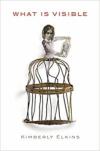I did research on my historical novel’s real-life characters, including Laura Bridgman and Julia Ward Howe, and their nineteenth-century milieu. Doing research at AAS was a fantastic experience all around.
Deeply enthralling and rich with lyricism, What is Visible chronicles the breathtaking experiment that Laura Bridgman embodied and its links to the great social, philosophical, theological, and educational changes rocking Victorian America. At age two, Laura Bridgman lost four of her five senses to scarlet fever. At age seven, she was taken to Perkins Institute to determine if a child so terribly afflicted could be taught. At age twelve, Charles Dickens declared her his prime interest for visiting America. And by age twenty, she was considered the nineteenth century’s second most famous woman, charming the world with her brilliance as the first deaf and blind person to master language—and blazing a trail for Helen Keller. With Laura—by turns mischievous, temperamental, and witty—as the book’s primary narrator, the fascinating kaleidoscope of characters includes the founder of Perkins Institute, Samuel Gridley Howe, with whom she was in love; his wife, the glamorous Julia Ward Howe, a renowned writer, abolitionist, and suffragist; Annie Sullivan; and even the young Helen Keller
What is Visible contemplates the bare requisites of being human, more fundamentally than most meditations on haves and have-nots... A novel's extraordinary power is to allow a reader to take possession of the inner life of another. This one provides entree to a nearly unthinkable life… a fascinating place to visit."
— Barbara Kingsolver, cover of the New York Times Book Review
What is Visible was chosen as a New York Times Book Review Editors' Choice, won the 2014 Langum Prize for Historical Fiction, and was picked for several Best of 2014 lists.
